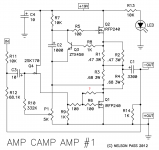nothing wrong in observing Papa's BAF lecture again
In Nelson Pass BAF 2015 presentation he only mentions that triode cruves are more desirable than pentode curves. But there was no comparision between Single ended MOSFET Mu-Follower and Single ended Schade MOSFET Mu-Follower in terms of performance or subjective sound evalution.
My best guess is Schaded feedback gives much lower amounts of higher ordered harmonic distortion.In Nelson Pass BAF 2015 presentation he only mentions that triode cruves are more desirable than pentode curves. But there was no comparision between Single ended MOSFET Mu-Follower and Single ended Schade MOSFET Mu-Follower in terms of performance or subjective sound evalution.
For example THD between the two versions maybe the same but the Schaded feedback may have far lower 3rd 4th 5th harmonic distortion. That could be completely wrong but that's my gut feeling on the matter.
Last edited:
One other thing worth mentioning.
Triode devices tend to be ideal voltage gain devices and pentodes tend to be ideal current gain devices.
The way Nelson has incorporated the schade feedback into the mu follower he has optimised the strengths of each part of the circuit. Triode for Common Source and pentode on follower (Common Drain).
I could be completely wrong on that too but that's what my gut says. Hahahaha
Triode devices tend to be ideal voltage gain devices and pentodes tend to be ideal current gain devices.
The way Nelson has incorporated the schade feedback into the mu follower he has optimised the strengths of each part of the circuit. Triode for Common Source and pentode on follower (Common Drain).
I could be completely wrong on that too but that's what my gut says. Hahahaha
ACA Schade
What about converting ACA amplifier into schade feedback? Is it doable without too many circuit changes? ACA is built by many, so lots of people can try it.
What about converting ACA amplifier into schade feedback? Is it doable without too many circuit changes? ACA is built by many, so lots of people can try it.
Here's another fake SIT variation - this one has been simulated, but not yet built.
http://www.diyaudio.com/forums/pass-labs/253485-amp-cramp-low-power-class-amp.html
http://www.diyaudio.com/forums/pass-labs/253485-amp-cramp-low-power-class-amp.html
Here's another fake SIT variation - this one has been simulated, but not yet built.
http://www.diyaudio.com/forums/pass-labs/253485-amp-cramp-low-power-class-amp.html
R8 is the magic ?
I could be completely wrong but I already see a Schade Feedback loop of some sort in ACA, except it is fed back to the gate of the low Ciss Jfet so a higher impedance loop can be used.maybe this?
which amount to R8 in the ACA?
I could be completely wrong but I already see a Schade Feedback loop of some sort in ACA, except it is fed back to the gate of the low Ciss Jfet so a higher impedance loop can be used.
Good.
thanks
A warning - those of you who venture into fake (or real) SIT-land - a SIT or fake SIT can gobble huge amounts of current when overdriven. When can that happen, you say?
Case in point - if one of your sources has some DC at the output, this can cause enough of a momentary overdrive (even if you are prudent and have an input coupling cap in place) to cause the amp in question to blow an input fuse. This happened to me last night with my latest "Le Fake" amp, while switching in an Oppo DVD player. The resulting current draw blew a 3A fast-blow fuse.
Corrective measures -
1) Use a slow-blow fuse at the input
2) Identify the bad boys and insert a high quality coupling cap at the output with a few hundred k on the downstream side (this can be done in series with the output cable if you are squeamish about tinkering with the guts of the bad boy in question).
3) Use a circuit breaker instead of a fuse for input protection
Case in point - if one of your sources has some DC at the output, this can cause enough of a momentary overdrive (even if you are prudent and have an input coupling cap in place) to cause the amp in question to blow an input fuse. This happened to me last night with my latest "Le Fake" amp, while switching in an Oppo DVD player. The resulting current draw blew a 3A fast-blow fuse.
Corrective measures -
1) Use a slow-blow fuse at the input
2) Identify the bad boys and insert a high quality coupling cap at the output with a few hundred k on the downstream side (this can be done in series with the output cable if you are squeamish about tinkering with the guts of the bad boy in question).
3) Use a circuit breaker instead of a fuse for input protection
- Status
- Not open for further replies.
- Home
- Amplifiers
- Pass Labs
- Schade circuit using IRFP240's
